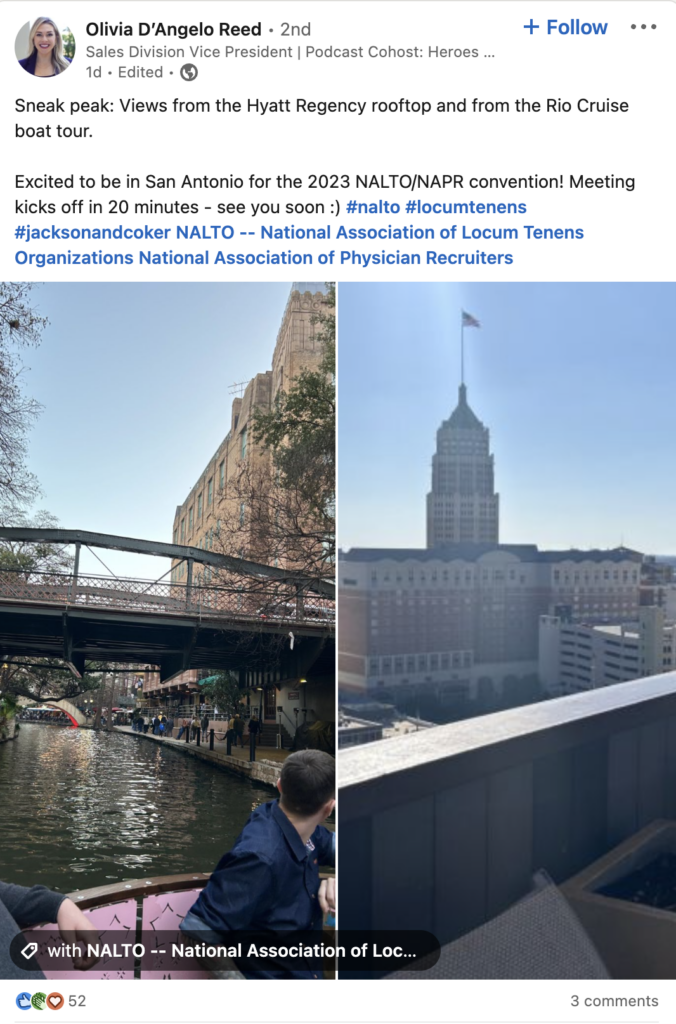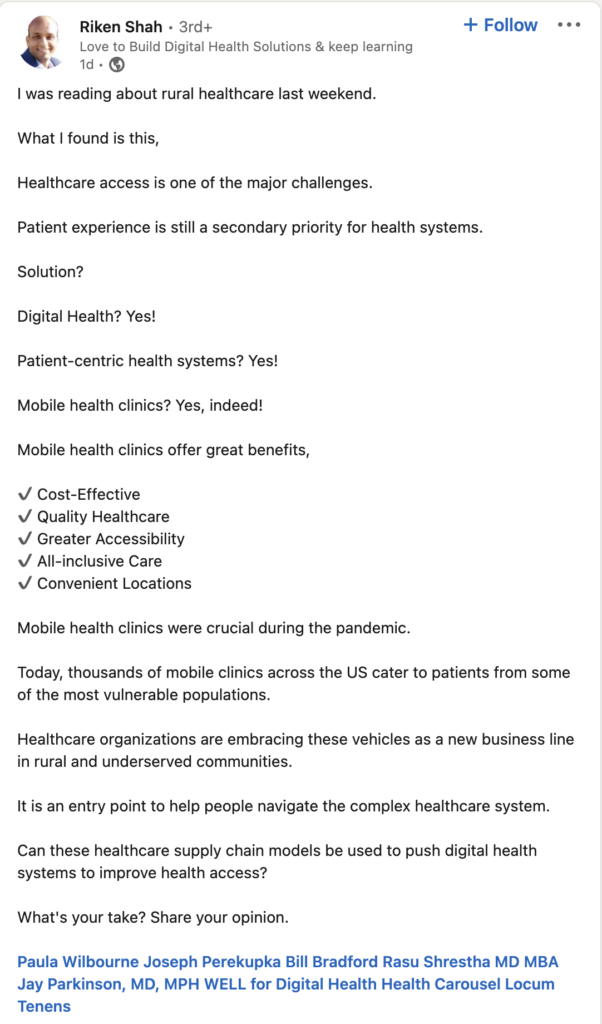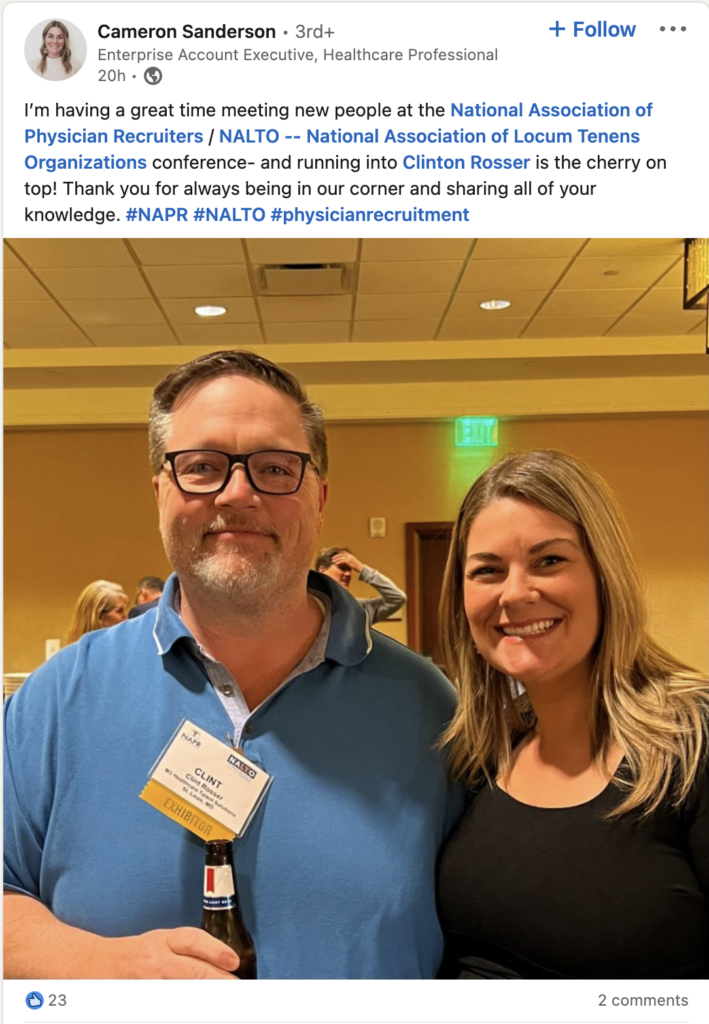In This Issue:
- Healthcare Labor Trends in 2023: Increased Burnout, Executive Stress
- VISTA Staffing Solutions Names Andrea Nelson Its New President
- Physicians Increasingly Seek Flexibility; The Gig Economy Delivers
- Healthcare Staffing Industry Veterans Launch ConTemporary Locums
- Floyd Lee Locums Adds Talent to Its Roster
- Ingenovis Health to Pursue More Staffing Buys, CEO says
- Attend AAPPR’s National Conference in Austin, Texas
- Socially Speaking: Social posts of note from Jackson + Coker, OSP, UrbanBound, Locums Choice, Hayes & more
- How ‘Bout This: High US Healthcare Spending Produces Poor Outcomes
Got news? Submit it here, and we’ll include it in a future Locums Digest.
Healthcare Labor Trends in 2023: Increased Burnout, Executive Stress
(Edited from Healthcare Dive, 1/30/2023)
The nation’s healthcare workforce still is trying to recover from the COVID-19 pandemic nearly three years after it began. Meanwhile, labor shortages stress hospitals and clinicians, spurring increased burnout among staff ranging from nurses to executives.
In addition, healthcare workers across the country have waged strikes to gain higher pay and optimal staffing conditions in employment contracts, while resident physicians increasingly have involved themselves in labor organizing.
These labor trends will continue posing challenges to health systems this year as facilities work to get back to pre-pandemic operations and stem labor costs that rose last year, experts say.Using Temporary Labor to Stem Ongoing Staffing Shortages
Staffing shortages are expected to continue this year, especially among nurses, as widespread burnout and increased turnover hit the sector. Shortages have led to the ongoing use of (“costly”) contract labor to fill labor gaps even as severe COVID-19 hospitalization rates have declined.
In December 2022, the national average weekly pay rate for travel nurses was $3,173, according to data from the nurse staffing platform Vivian Health. That’s up from $1,894 in January 2020, representing an almost 60% increase.
Vivian Health Senior VP Tim Needham says high rates are expected to remain fairly static this year. Demand for contract labor costs this year should normalize at about 60% higher than 2019 levels, Jefferies Group analysts said in a January healthcare equities brief.
Ongoing heightened labor costs are posing financial challenges for systems. Although some are boosting permanent staff pay to attract needed workers, many still need to curb soaring labor costs.
“The cost differential between full-time staff and then contracted staff is continuing to pressure health systems to reassess their full-time employee compensation packages,” Needham said.
Organizing Among Residents, Interns Increasing
Throughout the pandemic, healthcare workers have acted on the labor front to improve working conditions.
While nurses have long been the face of union activity, resident-physician organizing has picked up in recent years, according to the Committee of Residents and Interns, a branch of the Service Employees International Union.
The fast-growing union representing doctors in training had five election wins in 2022, four in 2021, one in 2020, and two in 2019, according to CIR-SEIU. It currently represents about 25,000 members.
Organizing for doctors-in-training is expected to continue in the new year, with residents at Montefiore Medical Center in New York and Lifelong Medical Care in San Francisco currently entering an election for union representation, according to the union.
Last year, residents at three Los Angeles County hospitals and one Oakland, California-based hospital authorized strikes, though both groups reached deals with the systems beforehand and averted a work stoppage.
Strike threats from resident physicians are particularly tricky for hospitals because residents are more difficult to replace than nurses. Additionally, resident physician strikes threaten a facility’s ability to maintain operations in the event of a walkout, according to John August, director of healthcare labor relations at Cornell’s School of Industrial and Labor Relations.
Like nurses and other healthcare workers, unionized residents are pushing for better pay and adequate work support.
“Doctors are feeling that they’ve kind of turned a corner — for many years, they felt that their power and influence was being reduced due to consolidation of health systems and reimbursement systems and technology,” August said.
Burnout, Turnover Hit Executive Ranks
Reports first pointed to burnout hitting nurses and physicians as healthcare workers reported feeling stressed and exhausted emotionally.
Now even healthcare executives report burnout symptoms, leading some to consider career changes.
A December 2022 study from consulting firm WittKieffer found that nearly 75% of surveyed healthcare executives reported feeling burned out during the last six months of 2022, compared to 60% of respondents who reported burnout symptoms in 2018.
The survey, which included responses from 233 healthcare executives, also found that executives felt significantly less productive, unable to overcome challenges at work, and less determined to make an impact in their careers.
Increased overall burnout in the sector may lead to greater executive turnover, an effect which has been recorded among nurses.
Still, a number of executives currently leaving their posts likely delayed retirement to weather their organizations through the pandemic, according to Rachel Polhemus, a senior partner at WittKieffer’s Healthcare Practice.
“Each wave presented a different set of factors that really created an element of ‘I’m ready to step away and let a new leader come in and lead,’” Polhemus said.
Additionally, replacing executives could prove trickier post-pandemic.
“The skill sets and competencies organizations are looking for in executives are different than they were pre-COVID,” Polhemus said.
Hospitals are placing added value on candidates with experience in executive roles dealing with crisis management during the pandemic, Polhemus said, adding that job-seeking candidates also are looking at how organizations fared through the pandemic when deciding whether or not to accept offers.
All News Is Locums
VISTA Staffing Solutions Names Andrea Nelson Its New President
(Lightly edited from VISTA, 2/2/2023)
VISTA Staffing Solutions, Inc. (VISTA) has named Andrea Nelson its new president. Nelson previously served as the company’s chief operating officer.
“Andrea has deep experience in locum tenens staffing optimization, and she is a force in spearheading the transformation of companies, people, and technology,” said Sean Ebner, president of physician services for Ingenovis Health. “She is a proven leader focused on instilling a performance-driven organizational culture to deliver results for our clinicians and clients.”
As president, Nelson and her team will work to garner top Net Promoter Scores, deliver exceptional employee experience and retention, and develop new business and clinician pipeline strategies.
“The organization has experienced significant changes over time, and I look forward to overseeing its continued innovation, evolution, and success as part of the Ingenovis Health family,” Nelson said. Recently she guided VISTA through its acquisition by Ingenovis Health, a leader in healthcare workforce optimization.
VISTA is one of seven companies in the Ingenovis Health family of brands.
Physicians Increasingly Seek Flexibility; The Gig Economy Delivers
(Edited from LocumTenens.com, 1/31/2023)
New research shows 71% of clinicians working contract or locum tenens positions are experiencing “little to no burnout.”
The global pandemic may have exacerbated physician burnout, but it also has accelerated the growth of flexible staffing models. These models contribute to higher physician satisfaction and potentially better outcomes for healthcare systems, according to findings from a new survey of over 2,500 clinicians by LocumTenens.com.
Study results outlined in the newly published The Future Of Work: Redefining The Role Of Physicians In The Gig Economy report include insights on burnout, scheduling, and technology in both traditional and nontraditional, as well as non-clinical, roles.
“The rise of the gig economy requires adaptation and transformation when it comes to workforce planning and management,” Locum Tenens.com President Chris Franklin said. “It’s no longer business as usual. Organizations that embrace flexible models that are augmented by technology solutions will be well-positioned to attract talent and improve clinician satisfaction, which can only improve healthcare outcomes.”
Many of the themes that have played out in healthcare were validated by these survey findings, including:
- Physicians and advanced practice providers (APPs) are still experiencing burnout.
- 40% self-reported that they are at least moderately burned out, with 17% saying they are “significantly” or “completely” burned out.
- However, 71% of contractors and locum tenens clinicians reported “little to no burnout.”
- Physicians are restless.
- At least 61% of physicians who said they are currently practicing report they are likely to look for a new position within the next year.
- Overall, 27% of physicians who said they will look for a new job reported being dissatisfied with their current position.
- The “currently-not-practicing” rate is increasing among younger physicians.
- 21% are under age 40, 34% are in their 40s, and 24% are in their 50s.
- More physicians are open to working locum tenens than ever before.
- Of those not currently working locum tenens but willing to consider it, 73% said they would be interested in local contract work, and 63% said they would be interested in a locums position that required travel.
- 55% agree they’d like to work more hours virtually via telehealth.
“The healthcare landscape is shifting, and physicians are not just moving with it – they are embracing it in an effort to create a better quality of life for themselves,” Franklin noted.
“The other thing that is changing somewhat dramatically is the perception of locum tenens, which has historically been stigmatized as a ‘path of last resort.’ According to our data, 96% of peers report that they value the contribution of the locum tenens clinicians working in their facilities,” Franklin added.
The Future Of Work: Redefining The Role Of Physicians In The Gig Economy report includes additional insights on roles and preferences of APPs, as well as a breakdown of data based on age and specialty.
Healthcare Staffing Industry Veterans Launch ConTemporary Locums
(Edited from Yahoo Life/PRNewswire, 1/18/2023)
Healthcare staffing industry veteran Sigrid Boring today announced the launch of ConTemporary Locums, LLC, a majority women-owned and -operated business and the third healthcare staffing start-up venture by Founder and CEO Sigrid Boring.
Following her career at AMN Healthcare, Boring led Host Healthcare, named one of Staffing Industry Analysts’ largest and fastest growing companies in 2022. In 2015, she launched Locums Unlimited, which became Aya Locums after its 2018 acquisition by Aya Healthcare, the nation’s largest privately owned healthcare staffing company.
“We continue to see unprecedented demand from hospitals for temporary physician staffing services,” Boring said. “With a team experienced in healthcare staffing, we started ConTemporary Locums to meet this demand head-on.”
ConTemporary Locums seeks to “improve the physician staffing experience and offer the most diverse physician expertise and candidate pool to its clients,” Boring noted.
She has recruited three other industry veterans to her company’s board of directors. Melissa Byington brings more than 20 years of healthcare staffing leadership experience, including her current role as CEO of Synchronized Solutions, a locums MSP Solution. Byington also served as chief sales officer for Supplemental Healthcare and as group president at CHG Healthcare, where she held various leadership roles over more than 21 years.
The board will include Eric Casazza, the CEO of FMT Consultants and a former executive at AMN Healthcare, and Brent Rivard, a former finance and operations leader at AMN and former partner and managing director at commercial real estate investment firm Pathfinder Partners.
Floyd Lee Locums Adds Talent to Its Roster
(Edited from Floyd Lee Locums, 1/10/2023)
Floyd Lee Locums has promoted Joanna Van Oss to vice president of learning & development. Van Oss is among more than 80 employees who are expanding the Charleston-based agency’s footprint year-over-year.
“Jo started with us as a consultant and quickly became integral to building our organization,” Floyd Lee Locums COO Nicole Burleson said. “From designing our learning management system to training and coaching others, her contributions have helped us grow rapidly during turbulent times.”
Bringing more than 25 years of healthcare staffing experience, Van Oss joined Floyd Lee Locums in 2021. Before joining the organization, she served in other leadership positions, including director of operations at General Healthcare Resources (GHR) and vice president of operations at Supplemental Health Care.
Having begun the company in 2017 with 12 employees, Floyd Lee Locums continues to see double-digit headcount growth year-over-year. The agency’s crew now numbers 83 employees, with 52 added in the last year alone.
“We are truly blessed as a company,” CEO and Co-Founder Natasha Lee said. “Healthcare is coming out of a really tough time. In growing from 12 people when we launched to 27 people when COVID struck was a feat. Reaching 83 team members just a couple of years later was only possible with incredible staff who show up every day to do great work.”
The Healthcare Staffing Story
Ingenovis Health to Pursue More Staffing Buys, CEO says
(Edited from Ion Analytics, 1/30/2023)
Ingenovis Health, a private equity-backed healthcare staffing provider, will continue to participate in competitive auction processes for large, quality assets with the assistance of investment bank UBS and its primary lender, Citizens Bank, Ingenovis CEO Bart Valdez said.
However, the company also receives and invites direct approaches from potential targets, he added.
Growth Trend Will Continue
Valdez noted that Ingenovis acquired three companies via competitive auction processes last year. In December 2022, it acquired Phoenix-based Springboard Health. In April 2022, it acquired KKR-backed VISTA Staffing Solutions (with about 100 employees); and in January 2022, it acquired Orlando, Florida-based Healthcare Support Staffing (with about 220 employees). All three companies generated roughly $100M or more in revenue and have grown since their integration into Ingenovis, he said.
This year, the company expects up to three more deals, according to Valdez.
Ingenovis was formed in 2021 by Cornell Capital and Trilantic North America, merging several staffing companies, including Fastaff Travel Nursing, US Nursing Corp., Trustaff Management, and CardioSolution.
With a total of eight companies now combined, Ingenovis is generating nearly $2B in revenue with EBITDA margins around roughly 14%, Valdez said.
He shared that Ingenovis is “on the hunt” for companies generating between $75M and $200M in revenue that could expand its “ecosystem of healthcare staffing solutions” outside the hospital.
Carefully Targeting for Turbulent Times
Valdez described “areas of immediate interest” as companies that recruit nurses or doctors in the fields of behavioral health, tele-health, virtual health monitoring, or educational healthcare systems.
Also attractive are acute care staffing agencies that bring international nurses and doctors to the US. While currently operating in the US, Ingenvois will look to expand its global presence to countries like Germany and France, Valdez said.
Ideal targets have “sound tech or processes” that can be easily adapted into Ingenvois’ platform and are “scalable.” It wants good financials and strong management teams that want to stay and grow with the company, he noted.
Valdez expects more conservative buyers in 2023, given today’s high interest rates and market volatility.
“Acquisitions in this market were frenzied in 2021 and 2022,” he said. “But the financial markets have changed dramatically and there are probably fewer buyers out there now.”
Valdez said Ingenovis stands apart from competitors because it offers doctors and nurses full-time, part-time, and temporary positions, along with opportunities to work in underserved or rural communities.
Strategy Allows for Going Public or Being Acquired
Regarding an exit, Valdez said if Ingenovis were to double in size in roughly three years, it could consider an IPO, most likely on the NASDAQ. Other listed healthcare staffing players include AMN Healthcare [NYSE:AMN] and Cross Country Healthcare [NASDAQ:CCRN].
As an alternative to an IPO, Ingenovis could attract such suitors as human capital management (HCM) firms, he said, noting that larger players have reached out to learn more about the healthcare staffing space.
Valdez cited active HCM players, including Netherlands-based Randstad, Adecco USA, ManpowerGroup [NYSE:MAN], and Kelly Services, whose medical specialty unit was acquired by Texas-based Ingenesis in 2018.
Big tech and big retail companies are also increasingly investing in “healthcare tech” solutions outside the hospital, Valdez explained.
The CEO pointed to the likes of Apple [NASDAQ:AAPL] and Google [NASDAQ:GOOGL] on the technology side as well as CVS [NYSE:CVS] and Walgreens [NASDAQ:WBA] in retail.
“They used to compete on retail and pharmaceutical sales, but now they are competing on services,” Valdez said. “As more services leave acute care hospitals and go into service centers, it could be an efficient way to deliver healthcare.”
Tools to Try/News to Use
Attend AAPPR’s National Conference in Austin, Texas!

Join us for the 2023 AAPPR Annual Conference, March 22-24, at the Austin Convention Center in Austin, Texas. This conference draws physician and provider recruitment professionals, physician liaisons, administrators, CEOs, CMOs, VPs, and others involved in healthcare recruitment, retention, and onboarding.
With the theme “Advancing Connections,” the conference will offer insights from industry experts through keynote presentations, networking, exhibit-viewing, and breakout group sessions. Hear from and connect with peers and mentors throughout the conference who can share strategies that have worked in their organizations.
Discounted rates are available at the Hilton Austin Hotel, Westin Austin Downtown Hotel, and Residence Inn Austin Downtown Hotel. Book a Room.
Session Highlights:
- “Physician Panel: Job Search Insights from the Candidate’s Perspective”
Eric Martin, PracticeLink - “Healthcare Providers – Mental Health Is as Important as Physical Health”
Collin McKahin, Marvin Behavioral Health - “The 4 Disciplines of Execution in Physician Recruitment”
Clint Rosser & Laura Kleffner, PractieMatch - “Create Enticing Opportunities for Physicians by Using Maslow’s Hierarchy of Needs”
Katherine Byrne, Grace Clinic of Lubbock - “Strategic Provider Development Planning”
Christy Ricks, Ardent Health, & Ron Flower, 3D Health
How ‘Bout This?
High US Healthcare Spending Produces Poor Outcomes
(Edited from Becker’s Hospital Review, 1/31/2023)
A new Commonwealth Fund study found that the US spends two to four times as much on healthcare as most high-income countries, but the health outcomes need to catch up.
“US Healthcare from a Global Perspective, 2022: Accelerating Spending, Worsening Outcomes” is an ongoing report by the Commonwealth Fund that compares healthcare spending and outcomes, health status, and healthcare usage in the US with 12 other high-income nations and with the average for the 38 high-income Organization for Economic Co-operation and Development (OECD) members for which data are available.
The report’s highlights included:
- The United States remained the only OECD nation that does not offer universal health coverage despite spending nearly 18% of its GDP on healthcare.
- The US has the lowest life expectancy, at 77 years, compared to the average of 80 years for other wealthy nations.
- The US has the highest rates of avoidable deaths from causes such as diabetes, hypertensive disease, and certain cancers. Its suicide rate is among the highest.
- The US has the highest rate of people with multiple chronic conditions and an obesity rate nearly twice the OECD average.
- Physical assault, including gun violence, is seven times higher in the US than in high-income countries, except for New Zealand.
- US infant and maternal deaths are more than triple the rate of most other high-income countries.
“Americans are living shorter, less healthy lives because our health system is not working as well as it could be,” lead author Munira Gunja, senior researcher for the Commonwealth Fund’s International Program in Health Policy and Practice Innovations, said in the report.
“To catch up with other high-income countries, the Administration and Congress would have to expand access to healthcare, act aggressively to control costs, and invest in…social services we know can lead to a healthier population.”












